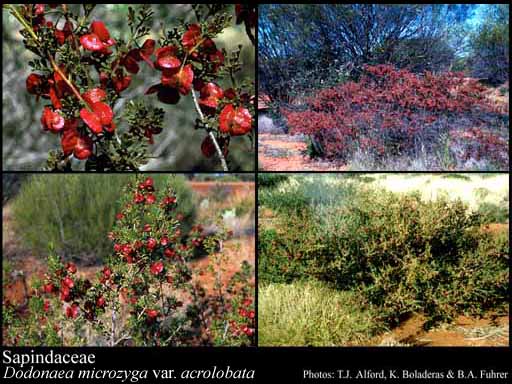- Reference
- Gen.Pl. [Jussieu] 246 (1789)
- Name Status
- Current

Scientific Description
Common name. Soapberry Family.
Habit and leaf form. Trees, or shrubs, or lianas, or herbs (rarely), or herbaceous climbers; laticiferous (often), or non-laticiferous and without coloured juice. Self supporting, or climbing; the climbers tendril climbers (the tendrils representing modified infloresences), or scrambling. Mesophytic. Leaves alternate; spiral; petiolate; non-sheathing; gland-dotted (often), or not gland-dotted; compound (usually), or simple; often pulvinate; usually ternate, or pinnate, or bipinnate, or multiply compound (sometimes biternate). Leaf blades when simple, dissected to entire; when simple/dissected, pinnatifid; pinnately veined; cross-venulate. Leaves with stipules (in some climbers), or without stipules. Domatia recorded (from 17 genera and numerous species); represented by pits, or pockets, or hair tufts. Stem anatomy. Nodes tri-lacunar. Secondary thickening developing from a conventional cambial ring, or anomalous; sometimes via concentric cambia (e.g. Serjania).
Reproductive type, pollination. Fertile flowers hermaphrodite, or hermaphrodite, functionally male, and functionally female, or hermaphrodite and functionally male, or hermaphrodite and functionally female. Unisexual flowers present. Plants monoecious, or polygamomonoecious, or polygamodioecious. Female flowers with staminodes (often), or without staminodes.
Inflorescence and flower features. Flowers solitary (rarely), or aggregated in ‘inflorescences’; in cymes. The terminal inflorescence unit cymose. Inflorescences usually cymes, thyrses or cincinni. Flowers usually bracteate; bracteolate (usually), or ebracteolate; small; regular to very irregular (often obliquely zygomorphic). The floral asymmetry involving the perianth and involving the androecium. Flowers often 4 merous, or 5 merous; cyclic; tetracyclic (usually), or tricyclic. Floral receptacle developing an androphore to developing a gynophore (e.g. sometimes in Dodonaea, by elongation of the intrastaminal disk), or with neither androphore nor gynophore. Free hypanthium absent. Hypogynous disk present (usually), or absent (or at least very indistinct, e.g. sometimes in Dodonaea); extrastaminal (the stamens usually within it, rarely upon it); annular or one-sided. Perianth with distinct calyx and corolla (usually), or sepaline (the corolla occasionally lacking, e.g. Dodonaea, Distichostemon); 3–6(–7) (rarely), or 8, or 10; 1 -whorled (rarely), or 2 -whorled (usually); isomerous, or anisomerous (e.g the abaxial petal sometimes missing). Calyx (3–)4, or 5(–7); 1 -whorled; polysepalous (usually), or partially gamosepalous (sometimes ostensibly 4-merous), or gamosepalous (sometimes basally connate); imbricate (usually), or valvate. Sometimes 2 of the members joined. Calyx unequal but not bilabiate, or regular; when K5, with the median member posterior. Corolla 4, or 5; 1 -whorled; appendiculate (often, the appendages basal, scalelike), or not appendiculate; gamopetalous (usually), or polypetalous (e.g. Koelreuteria); imbricate; unequal but not bilabiate, or regular. Fertile stamens present, or absent (female flowers). Androecium 8, or 10 (usually), or 4–5(–6), or 11–100 (i.e. sometimes ‘many’). Androecial members free of the perianth; free of one another; 2 -whorled (rather theoretically 5+5), or 1 -whorled, or 2–5 -whorled (sometimes polystemonous in 2–several series in Distichostemon). Androecium of male-fertile flowers exclusively of fertile stamens. Stamens 4–5(–6) (rarely), or 8, or 10, or 11–100 (rarely ‘many’); isomerous with the perianth (rarely, e.g. in Ganophyllum), or diplostemonous to polystemonous (usually); filantherous (the filaments often hairy). Anthers dorsifixed, or basifixed (to slightly ventrifixed); more or less versatile; dehiscing via longitudinal slits; introrse; tetrasporangiate; appendaged (usually), or unappendaged. The anther appendages apical (by connective extension). Fertile gynoecium present, or absent (male flowers). Gynoecium (2–)3(–8) carpelled. The pistil (2–)3(–8) celled. Carpels reduced in number relative to the perianth, or isomerous with the perianth. Gynoecium syncarpous; synovarious to eu-syncarpous; superior. Ovary plurilocular; (2–)3(–8) locular. Gynoecium stylate. Styles 1 (usually), or 2–4; free, or partially joined; attenuate from the ovary, or from a depression at the top of the ovary (rarely, from between the ovary lobes); apical. Stigmas wet type; non-papillate; Group IV type. Placentation axile to basal. Ovules 1(–2) per locule, or 2–5 per locule (Dodonaeoideae); funicled, or sessile (then attached to placental protuberances); pendulous, or horizontal, or ascending; apotropous; arillate (usually), or non-arillate; hemianatropous, or anatropous, or campylotropous, or amphitropous.
Fruit and seed features. Fruit fleshy, or non-fleshy; dehiscent, or indehiscent, or a schizocarp; when non-schizocarpic a capsule, or a berry, or a drupe, or a nut, or a samara. Capsules loculicidal, or splitting irregularly, or circumscissile. Seeds non-endospermic; with amyloid, or without amyloid. Cotyledons 2 (often plicate or twisted). Embryo chlorophyllous (4/6), or achlorophyllous (4/4); curved, or bent, or coiled. Seedling. Germination phanerocotylar, or cryptocotylar.
Physiology, biochemistry. Aluminium accumulation not found. Photosynthetic pathway: C3 and CAM.
Geography, cytology, number of species. World distribution: pantropical and subtropical, also Japan, and widespread in Australasia. X = 10–16. 2000 species.
Economic uses, etc. Fruits: ‘Spanish lime’ (Melicocca), litchi and longan (Litchi spp.), pulusan and rambutan (Nephelium spp.); Blighea with edible arils (‘akee’).
Keys
Western Australian Genera and Families of Flowering Plants — an interactive key
T.D. Macfarlane, L. Watson, N.G. Marchant